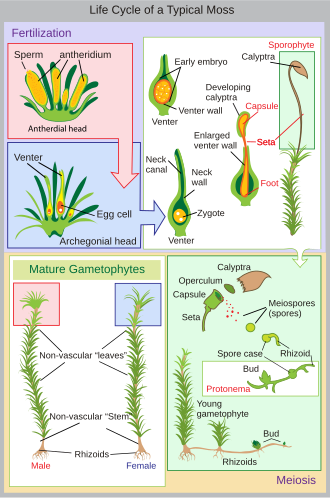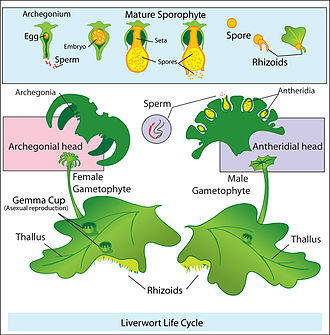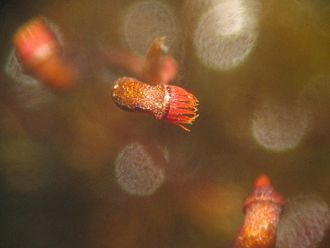AY Honors/Lichens, Liverworts & Mosses
Overview
The Challenging Part
The most challenging requirement of this honor is probably this:
100.
[[AY Honors/Lichens, Liverworts & Mosses/Requirements|Tab Name/Printable Version]]
1. Know the life cycle of a moss, lichen, or liverwort.
2. What are lichens?
3. Name at least two ways lichens have been of value to man.
4. How are liverworts different than all other green plants? Name one used in aquariums. What is its function?
5. Describe at least three significant ways moss has played in the economy of man.
6. Make a moss garden (small terrarium) or "eternal garden" using at least three different kinds of mosses and lichens.
7. Find and identify five lichens, one liverwort, and six mosses.
8. Observe the spore caps of several different kinds of moss under a magnifier to see the differences in "hair caps" and "teeth" that separate many species.
Printable Answer Key Tab Name/Edit Answer Key
1
Life cycle of moss
Most kinds of plants have a double portion of chromosomes in their cells (diploid, i.e. each chromosome exists with a partner that contains the same genetic information) whilst mosses have only a single set of chromosomes (haploid, i.e. each chromosome exists in a unique copy within the cell). There are periods in the moss lifecycle when they do have a full, paired set of chromosomes but this is only during the sporophyte stage.
The life of a moss starts from a haploid spore, which germinates to produce a protonema, which is either a mass of filaments or thalloid (flat and thallus-like). This is a transitory stage in the life of a moss. From the protonema grows the gametophore ("gamete-bearer") that is differentiated into stems and leaves ('microphylls'). From the tips of stems or branches develop the sex organs of the mosses. The female organs are known as archegonia (sing. archegonium) and are protected by a group of modified leaves known as the perichaetum (plural, perichaeta). The archegonia have necks called venters which the male sperm swim down. The male organs are known as antheridia (singular antheridium) and are enclosed by modified leaves called the perigonium (plural, perigonia).
Mosses can be either dioicous or monoicous. In dioicous mosses, both male and female sex organs are borne on different gametophyte plants. In monoicous mosses, they are borne on the same plant. In the presence of water, sperm from the antheridia swim to the archegonia and fertilization occurs, leading to the production of a diploid sporophyte. The sperm of mosses have two flagella that aid in propulsion. Without water, fertilization cannot occur. After fertilization, the immature sporophyte pushes its way out of the archegonial venter. It takes about a quarter to half a year for the sporophyte to mature. The sporophyte body comprises a long stalk, called a seta, and a capsule capped by a cap called the operculum. The capsule and operculum are in turn sheathed by a haploid calyptra which is the remains of the archegonial venter. The calyptra usually falls off when the capsule is mature. Within the capsule, spore-producing cells undergo meiosis to form haploid spores, upon which the cycle can start again. The mouth of the capsule is usually ringed by a set of teeth called peristome. This may be absent in some mosses.
In some mosses, green vegetative structures called gemmae are produced on leaves or branches, which can break off and form new plants without the need to go through the cycle of fertilization. This is a means of asexual reproduction.
Life cycle of lichen
Many lichens reproduce asexually, either by vegetative reproduction or through the dispersal of diaspores containing algal and fungal cells. Soredia (singular soredium) are small groups of algal cells surrounded by fungal filaments that form in structures called soralia, from which the soredia can be dispersed by wind. Another form of diaspore are isidia, elongated outgrowths from the thallus that break off for mechanical dispersal. Fruticose lichens in particular can easily fragment. Due to the relative lack of differentiation in the thallus, the line between diaspore formation and vegetative reproduction is often blurred. Many lichens break up into fragments when they dry, dispersing themselves by wind action, to resume growth when moisture returns.
Many lichen fungi appear to reproduce sexually in a manner typical of fungi, producing spores that are presumably the result of sexual fusion and meiosis. Following dispersal, such fungal spores must meet with a compatible algal partner before a functional lichen can form. This may be a common form of reproduction in basidiolichens, which form fruitbodies resembling their nonlichenized relatives. Among the ascolichens, spores are produced in spore-producing bodies, the three most common spore body types are the apothecia, perithecia and the pycnidia.
Life cycle of liverwort
The life of a liverwort starts from the germination of a haploid spore to produce a protonema, which is either a mass of thread-like filaments or else a flattened thallus. The protonema is a transitory stage in the life of a liverwort, from which will grow the mature gametophore ("gamete-bearer") plant that produces the sex organs. The male organs are known as antheridia (singular: antheridium) and produce the sperm cells. Clusters of antheridia are enclosed by a protective layer of cells called the perigonium (plural: perigonia). As in other land plants, the female organs are known as archegonia (singular: archegonium) and are protected by the thin surrounding perichaetum (plural: perichaeta). Each archegonium has a slender hollow tube, the "neck", down which the sperm swim to reach the egg cell.
Liverwort species may be either dioicous or monoicous. In dioicious liverworts, female and male sex organs are borne on different and separate gametophyte plants. In monoicious liverworts, the two kinds of reproductive structures are borne on different branches of the same plant. In either case, the sperm must swim from the antheridia where they are produced to the archegonium where the eggs are held. The sperm of liverworts have two tail-like flagellae that aid in propulsion. Their journey is further assisted either by the splashing of raindrops or the presence of a thin layer of water covering the plants. Without water, the journey from antheridium to archegonium cannot occur.
In the presence of such water, sperm from the antheridia swim to the archegonia and fertilization occurs, leading to the production of a diploid sporophyte. After fertilization, the immature sporophyte within the archegonium develops three distinct regions: (1) a foot, which both anchors the sporophyte in place and receives nutrients from its "mother" plant, (2) a spherical or ellipsoidal capsule, inside which the spores will be produced for dispersing to new locations, and (3) a seta (stalk) which lies between the other two regions and connects them. When the sporophyte has developed all three regions, the seta elongates, pushing its way out of the archegonium and rupturing it. While the foot remains anchored within the parent plant, the capsule is forced out by the seta and is extended away from the plant and into the air. Within the capsule, cells divide to produce both elater cells and spore-producing cells. The elaters are spring-like, and will push open the wall of the capsule to scatter themselves when the capsule bursts. The spore-producing cells will undergo meiosis to form haploid spores to disperse, upon which point the life cycle can start again.
2
Lichens are symbiotic associations of a fungus with a photosynthetic partner (called a photobiont) that can produce food for the lichen from sunlight. The photobiont is usually either green alga or cyanobacterium.
3
Soil Stabilization
Most lichens grow on stable rock surfaces or the bark of old trees, but many others grow on soil and sand. In these latter cases, lichens are often an important part of soil stabilization; indeed, in some desert ecosystems, vascular (higher) plant seeds cannot become established except in places where lichen crusts stabilize the sand and help retain water.
Lichen also creates soil from rock. Lichens that grow on rock patiently collect water and retain it. When the water freezes, it expands and chips away minerals from the surface of the rock. These minerals are then held in place by the lichen.
Feed for livestock
Lichens may be eaten by some animals, such as reindeer. In arctic regions where reindeer are raised as livestock, lichen is their main source of feed.
Pollution indicator organisms
Although lichens typically grow in naturally harsh environments, most lichens, especially epiphytic fruticose species and those containing cyanobacteria, are sensitive to manufactured pollutants. Hence, they have been widely used as pollution indicator organisms.
Medicine and dyes
Many lichens produce secondary compounds, including pigments that reduce harmful amounts of sunlight and powerful toxins that reduce herbivory or kill bacteria. These compounds are very useful for lichen identification, and have had economic importance as dyes or primitive antibiotics. Extracts from many Usnea species were used to treat wounds in Russia in the mid-twentieth century. Orcein and other lichen dyes have largely been replaced by synthetic versions.
4
Liverworts have a unicellular, root-like structure called a rhizoid which anchors it to its substrate. Many other plants have rhizoids, but only in the liverwort is the rhizoid unicellular.
One of the more than 100 species in the liverwort genus Riccia is the "slender riccia" (Riccia fluitans), which can be found floating in ponds, and is sometimes used in aquariums. It is sometimes called crystalwort. It is used in aquariums as a retreat for young fry and is used in live-bearing tanks. It is also used as an oxygenator, as bottom cover, and as bubble-nest support.
5
Agriculture
Peat (Sphagnum moss) is used to loosen and fertilize soil for agriculture. It is also used in the construction material Peatcrete, and it has been used as fuel.
Landscaping
Moss is used as a base layer in the art of bonsai. It is also a popular terrarium plant.
Medicine
Moss was used for dressing wounds during World War I. It was also used as pillow filler for soldiers to rest upon when they were transported from the battlefield to the hospital.
Wallpaper
Sphagnum moss was used as wallpaper in the early 1900's.
6
Note: This activity meets a requirement in the Ranger AY Nature Study curriculum.
A terrarium may be constructed from any clear container of nearly any size, from baby food jars to storage tubs.
Start by putting down a layer of gravel, rocks, vermiculite or Perlite. Then place a layer of soil on top of this. Place the plants atop the soil and add a few rocks for interest. Water once, but do not overwater. Put the lid on and place the container in a place where it can receive indirect sunlight. If algae begins to grow on the container walls, move to a more shady location. You should not need to open the lid for months, as the terrarium will develop its own climate, and all the moisture remains in the container.
7
There are thousands of species of lichens, liverworts, and mosses, and providing an identification guide is well beyond the scope of this chapter. In order to meet this requirement, you will most likely need to obtain a field guide. Here are a few possibilities:
- Plants without leaves;: Lichens, fungi, mosses, liverworts, slime-molds, algae, horsetails
- Walk Softly Upon the Earth, a Pictorial Field Guide to Missouri Mosses, Liverworts and Lichens
Another alternative is to find an online key:
- Mosses
The best approach for this requirement is to familiarize yourself with these plants as much as you can, and then go outside and see what's there. Whenever you come across a specimen, try to identify it. If possible, collect a bit of it and take it home for a closer examination. This is far better than deciding that you are going to go out and find Cladonia portentosa. In other words, instead of deciding what you're going to find and then going out to look for it, go out and see what's there and then identify it.
8
The Bryopsida constitute the largest class of mosses, containing 95% of all moss species. It consists of approximately 9,500 species, common throughout the whole world.
The group is distinguished by having spore capsules with teeth that are arthrodontous; the teeth are separate from each other and jointed at the base where they attach to the opening of the capsule. These teeth are exposed when the covering operculum falls off. In other groups of mosses, the capsule is either nematodontous with an attached operculum, or else splits open without operculum or teeth.
Capsule structure
Among the Bryopsida, the structure of the capsule (sporangium) and its pattern of development is very useful both for classifying and for identifying moss families. Most Bryopsida produce a capsule with a lid (the operculum) which falls off when the spores inside are mature and thus ready to be dispersed. The opening thus revealed is called the stoma (meaning "mouth") and is surrounded by one or two peristomes. A peristome is a ring of triangular "teeth" formed from the remnants of specially thickened cell walls. There are usually 16 such teeth in a single peristome, and in the Bryopsida the teeth are separate from each other and able to both fold in to cover the stoma as well as fold back to open the stoma. This articulation of the teeth is termed arthrodontous.
There are two basic arthrodontous peristome types. The first is termed haplolepidous and consists of a single circle of 16 peristome teeth. The second type is the diplolepidous peristome fround in subclass Bryidae. In this type, there are two rings of peristome teeth—an inner endostome (short for endoperistome) and an exostome. The endostome is a more delicate membrane, and its teeth are aligned between the teeth of the exostome. There are a few mosses in the Bryopsida that have no peristome in their capsules. These mosses still undergo the same cell division patterns in capsule development, but the teeth do not fully develop.
For more information, see
References
Content on this wiki is generated by people like you, and no one has created a lesson plan for this honor yet. You could do that and make the world a better place.
See AY Honors/Model Lesson Plan if you need ideas for creating one.



